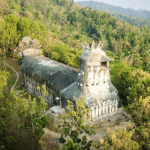 Technology
Technology  Technology
Technology  Humans
Humans 10 Everyday Human Behaviors That Are Actually Survival Instincts
 Animals
Animals 10 Animals That Humiliated and Harmed Historical Leaders
 History
History 10 Most Influential Protests in Modern History
 Creepy
Creepy 10 More Representations of Death from Myth, Legend, and Folktale
 Technology
Technology 10 Scientific Breakthroughs of 2025 That’ll Change Everything
 Our World
Our World 10 Ways Icelandic Culture Makes Other Countries Look Boring
 Misconceptions
Misconceptions 10 Common Misconceptions About the Victorian Era
 Mysteries
Mysteries 10 Strange Unexplained Mysteries of 2025
 Miscellaneous
Miscellaneous 10 of History’s Most Bell-Ringing Finishing Moves
 Technology
Technology Top 10 Everyday Tech Buzzwords That Hide a Darker Past
 Humans
Humans 10 Everyday Human Behaviors That Are Actually Survival Instincts
 Animals
Animals 10 Animals That Humiliated and Harmed Historical Leaders
Who's Behind Listverse?

Jamie Frater
Head Editor
Jamie founded Listverse due to an insatiable desire to share fascinating, obscure, and bizarre facts. He has been a guest speaker on numerous national radio and television stations and is a five time published author.
More About Us History
History 10 Most Influential Protests in Modern History
 Creepy
Creepy 10 More Representations of Death from Myth, Legend, and Folktale
 Technology
Technology 10 Scientific Breakthroughs of 2025 That’ll Change Everything
 Our World
Our World 10 Ways Icelandic Culture Makes Other Countries Look Boring
 Misconceptions
Misconceptions 10 Common Misconceptions About the Victorian Era
 Mysteries
Mysteries 10 Strange Unexplained Mysteries of 2025
 Miscellaneous
Miscellaneous 10 of History’s Most Bell-Ringing Finishing Moves
10 Unusual Aquatic Events from around the World
Given the necessity of water for humanity’s survival and the fact that 71% of Earth’s surface is covered with water, it’s really no surprise that there are numerous events and festivals around the world that heavily feature H2O. Some of these water-based events are well-known, such as the water festivals used to celebrate the new year in some Southeast Asian countries, but many of them are a little more obscure and sometimes rather bizarre! Let’s dive into these 10 unusual but amazing aquatic events.
Related: 10 Famous Festivals That Ended In Complete Disaster
10 Hair Freezing Contest, Canada
Eclipse Nordic Hot Springs, around a half-hour drive from Whitehorse, Yukon, holds an annual Hair Freezing Contest. It kicks off once the temperature plummets to -4°F (-20°C) and then runs until March 25th. Participants dip their heads into the 104°F (40°C) water of the hot springs, shape their hair into amusing styles, and then let the freezing air set the style. When the frost has fully taken hold, entrants ring the bell by the pool entrance so that staff can come to take a picture.
There are currently six categories: Best Male, Best Female, Best Group, People’s Choice, Most Creative, and Best Facial Hair. As well as being a bit of fun, serious money is also up for grabs. The winner of each category receives $2,000 CA (around $1,500 US). A gallery of the frosty and fabulous past winners can be viewed online.[1]
9 World Bog Snorkeling Championship, Wales
One of the strangest sporting events in the world is the World Bog Snorkeling Championships, which is held in Wales. The competition takes place in August each year in Waen Rhydd bog, just outside the town of Llanwrtyd Wells. Competitors don snorkels and flippers and then swim two lengths of a 60-yard (55-meter) trench in the muddy bog. Conventional swimming strokes, such as front crawl and breaststroke, aren’t allowed. Instead, swimmers must rely mostly on flipper power (although doggy paddle is allowed).
While some competitors choose to wear a simple wetsuit, many others dress up in fun—and sometimes impractical—costumes, such as a pantomime horse or a bunch of grapes. The current fastest time was set by Neil Rutter in 2023, who clocked in at 1 minute and 12.34 seconds.[2]
8 Śmigus-Dyngus, Poland
Easter Monday is typically celebrated with egg rolling competitions, the eating of chocolate Easter eggs, and attendance at church for those who are religious, but Poland celebrates the day a little differently. Essentially, it holds a nationwide water fight. Known as Śmigus-dyngus, lany poniedziałek (Wet Monday), or Dyngus Day, the origins of this event go back to at least the 14th century.
Traditionally the day saw boys throwing water over girls and then hitting them with pussy willow branches (which sounds cruel but was done in good humor!). Nowadays, the water-throwing isn’t limited by age or gender, and everybody joins in. Polish communities in countries outside Poland also use the day as a chance to celebrate their culture. In the USA, two of the biggest events are held in Buffalo and Cleveland, with both cities hosting events such as parades, Miss Dyngus Day pageants, live polka music, and pierogi eating competitions.[3]
7 Underwater Music Festival, Florida, USA
There are a lot of music festivals in the world, but one of the most unusual takes place at the bottom of the sea off the coast of the Florida Keys. Started in 1984, the Underwater Music Festival gives scuba divers and snorkelers a chance to listen to music while swimming through endangered coral reefs.
The event was created because Keys locals wanted to do something to help save the reefs. Dave Turner, executive director of the Lower Keys Chamber of Commerce, told Smithsonian Magazine that they “wanted to figure out a way to bring awareness to our coral reefs that would preserve them and rebuild them and restore them in any way. They came up with this idea to play music underwater and invited divers and snorkelers to listen while also enjoying the local sea life.”
The event proved to be a hit, and each year, divers gather under the surface to listen to water-themed songs, such as “Fins” by Jimmy Buffett and “Yellow Submarine” by The Beatles. Many of the divers dress up in fun costumes (mermaids are a popular choice!), and some even bring along sea-life-inspired musical instruments. In recent years, the nearby Mote Marine Laboratory has also hosted events on dry land that highlight the importance of their coral restoration work.[4]
6 The Loony Dook, Scotland
In Scotland, New Year’s Eve, known as Hogmanay, is typically celebrated with the consumption of large quantities of alcohol. Some people decide to chase this the next day with a swim in the freezing cold waters of the Firth of Forth at South Queensferry. The event was first held on January 1st, 1987, after Jim Kilcullen said to his friends, “Ach, let’s jump in the Forth on New Year’s Day, maybe it’ll clear the hangovers!”
Known as the Loony Dook—loony being short for “lunatic” and dook meaning “dip/plunge” in Scots—this small tradition between friends soon grew into an officially organized event that draws hundreds of participants each year (plus many observers who choose to stay dry on the shore). However, the Dook is no longer an official part of Edinburgh Hogmanay’s schedule. It was criticized for becoming too commercial, with an entrance fee of up to £20 ($25) being introduced.
The event is now once again locally organized, and it’s free to participate (with donations to the Royal National Lifeboat Institution being encouraged). Many loonies take the plunge in regular swimming gear, but others choose to don silly outfits.[5]
5 Death Diving World Championship, Norway
Despite its scary name, death diving doesn’t actually involve death. Death diving simply means that instead of entering the water in as streamlined a position as possible, divers fall in a belly flop position and then curl into either a cannonball or a shrimp/fetal position just before hitting the water (otherwise, they would be seriously injured!). The freestyle version allows divers to twist into spectacular positions before hitting the water.
The creation of this style of diving is attributed to Erling Bruno Hovden, the guitar player in Raga Rockers. Since 2008, Norway’s Døds Diving World Championship (døds meaning “death” in Norwegian) has been the biggest platform for death divers to show off their skills. Divers are judged on the speed and length of their dive, while the freestyle category is also marked according to style and creativity.
TikTok has helped the extreme sport draw even more eyes, with skilled døds diver Asbjorg Nesje having a video of her dive from 81 feet (24.8 meters) go viral. Although it looks like a dangerous belly flop, her hands and feet break the surface tension before her body hits the water.[6]
4 Argungu Fishing Festival, Nigeria
Since 1934, the Mata Fadan River in Kebbi State, Nigeria, has played host to the Argungu Fishing Festival, which sees around 50,000 men launch themselves into its waters to catch the biggest fish. The competition is chaotic as the tens of thousands of men frantically scramble to catch fish in nets. The festival is held in February when possible (it had to be halted for a few years because of low water levels). It is a celebration of unity, with the inaugural event marking the end of hostilities between the Kebbi Kingdom and the Sokoto Caliphate.
The river is around 164 feet (50 meters) wide and 50 feet (15 meters) deep. A stretch of it is left untouched throughout the year so that fish are plentiful by the time the festival rolls around. In 2020, the winning fish weighed 172 pounds (78 kilograms), and the fisherman was rewarded with 10 million naira (around $11,000), two cars, and the opportunity to undertake the Muslim pilgrimage to Mecca, Saudi Arabia.[7]
3 Kasedori Festival, Japan
Yamagata Prefecture in Japan is often covered in a blanket of snow in February, but on the 11th, some people strip off their warm coats and don an outfit made of straw. This is for the Kasedori Festival, or Strawbird Festival, which dates back to the Edo period in the 1600s. People dress up as kasedori, which are said to be divine messengers, and dance in a circle while everyone chants “Ka-ka-ka!”
While this is going on, spectators throw water on the kasedori performers, which supposedly brings luck in business, a successful harvest, and protection from fires. Although some people warm the water up before throwing it, most of the time, it’s freezing cold. And while some merely sprinkle the water, others throw entire buckets.[8]
2 Darwin’s Beer Can Regatta, Australia
The city of Darwin in Northern Australia holds an annual regatta unlike any other: all the competing boats are made out of cans. The race was first held at Mindil Beach in 1974, with founder Lutz Frankenfeld explaining that the townspeople “were concerned about the amount of rubbish around. You could drive up from Katherine and find Darwin quite easily with all the cans along the road, so it was a matter of cleaning up the town and putting something together.”
The boats certainly use up a lot of cans, with a regular boat being built out of around 2,500 of them. Some of the boats have been far larger than that, though, with veteran competitor Mick Keeley once building a boat out of 30,000 cans—he called it Extravacanz. The mammoth construction had two levels and even a water cannon. “We had 87 people on the boat at one stage, so a lot of people will remember seeing that one,” Keeley recalls.
As well as the race portion of the event, the boats also take part in the Battle of Mindil. Although billed as a treasure hunt, the competitors are allowed to try and steal the treasure from each other, which results in a lot of good-natured and amusing boat destruction.[9]
1 Jindo Miracle Sea Road Festival, South Korea
Moses’s parting of the Red Sea in the Bible may be miraculous, but this phenomenon actually happens like clockwork each year off the coast of South Korea. Every spring, the Yellow Sea parts a couple of times to reveal a path between the islands of Jindo and Modo. The Jindo Miracle Sea Road Festival, also known as the Jindo Sea Parting Festival, sees crowds gather to watch the parting and then walk the nearly 2-mile (3-kilometer) path.
The Korean legend about the sea parting says that the residents of Jindo were driven from the island by tigers. They fled to nearby Modo, but one person, called Bbyong, was accidentally left behind. She prayed to Yongwang, the dragon god of the sea, to be saved, and he parted the sea for her to escape.
Science puts the parting down to tidal harmonics, lowering the sea to reveal a raised ridge. Each spring, the movement of the earth, in combination with the specific gravitational pull of the sun and moon at that time, causes an unusually low tide. As for the walkable path—which is roughly 130 to 200 feet wide (40 to 60 meters)—cutting through the water, Kevan Moffett, a geoscience professor, explains that it was likely created “because the sediment has preferentially deposited at that one spot due to relatively calmer water occurring along that line between the islands.”[10]








